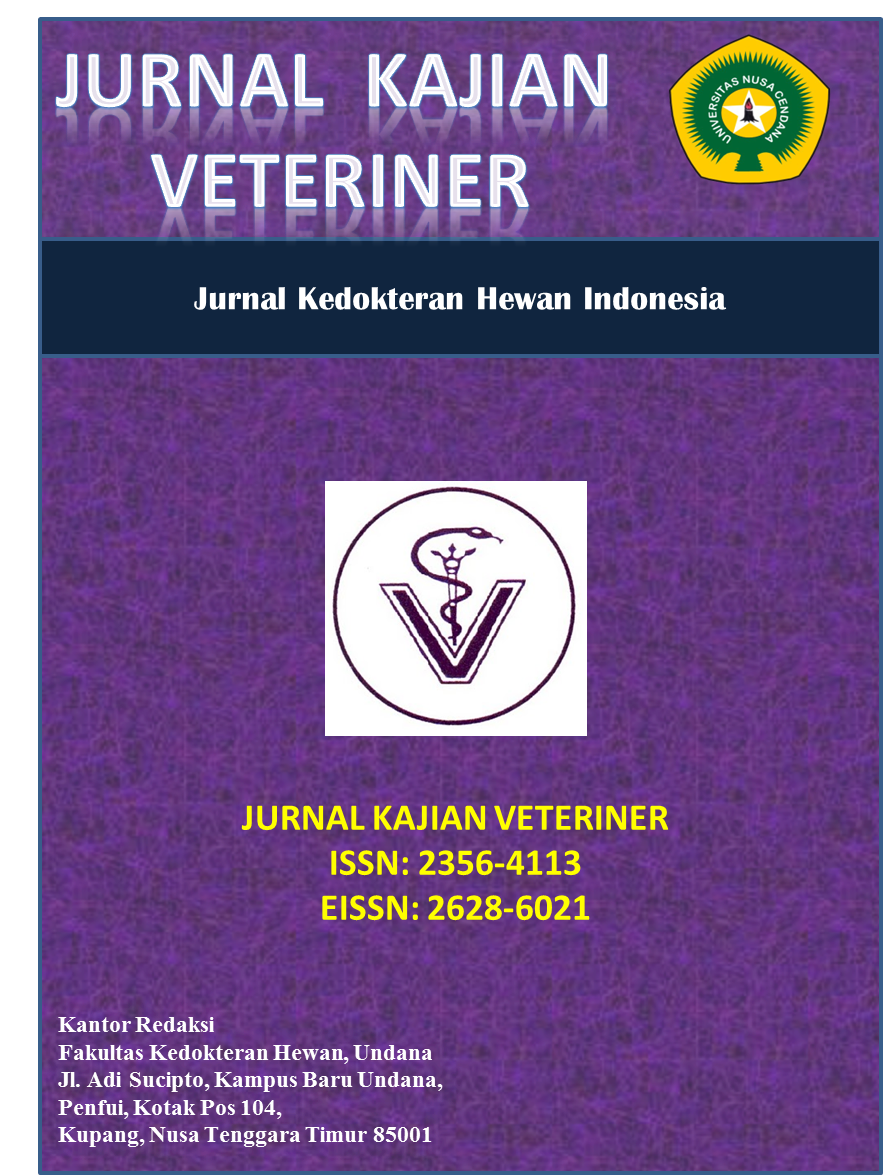PROFIL FITOKIMIA EKSTRAK ETANOL DAUN ANTING – ANTING (ACALYPHA INDICA LINN) DI KOTA KUPANG, NTT
PHYTOCHEMICAL PROFILE OF ACALYPHA INDICA LINN LEAVES ETHANOLIC EXTRACT IN KUPANG CITY, NTT
Abstract
Acalypha indica Linn is a tropical weed, grows annually in East Nusa Tenggara. The weed is member of Euphorbiaceae family, a largest plant family known as medicinal plant. The weed leaves were used by local people in NTT to treat wounds, diseases or myasis on their livestock. This study aim to investigate the secondary metabolites in A. indica L leaves as a scientific proven for its local use.
The extract preparation comprises of several steps, i.e collection of fresh leaves, dry and wet sortation. The clean leaves were air dried in a room temperature for about 2 weeks before grounded into powder and subjected to extraction. The extraction method was maceration with ethanol 96% as solvent. The dense extract was evaporated using rotary evaporator and subjected to phytochemical screening.
The result shows that ethanol extract of A.indica leaves were tested positive for flavonoid and tannin. Alkaloid, saponins, triterpenes and steroid were tested negative on the extract.
Downloads
References
Baury RK, Tigga MN, Kullu SS. 2015. A Review on Medicinal Plants To Control Parasites. Indian Journal of Natural Products and Resources 6 (4); 268-277
Chekuri S, Lingfa L, Panjala S, Sai Bindu KC, Anupali RR. 2020. Acalypha indica L. - an Important Medicinal Plant: A Brief Review of Its Pharmacological Properties and Restorative Potential. EJMP 31(11): 1-10
Chekuri S, Vankudothu N, Panjala S, Babu Rao N, Anupali RR. 2016. Phytochemical Analysis, Anti-oxidant and Anti-microbial Activity of “Acalypha indica” Leaf Extracts in Different Organic Solvents. Int. J. Phytomedicine 8(3): 444-452
Dalimarta, S. 2000. Atlas Tumbuhan Obat Indonesia Jilid 2. Trubus Agriwidjaya, Jakarta.
Departemen Kesehatan Republik Indonesia. 2007. Kebijakan Obat Tradisional Nasional. Keputusan Menteri Kesehatan Republik Indonesia Nomor: 381/Menkes/SK/III/2007 Tanggal 27 Maret 2007. Jakarta: Departemen Kesehatan Republik Indonesia.
Ergina, Nuryanti S, Pursitasari ID. 2014. Uji Kualitatif Senyawa Metabolit Sekunder pada Daun Palado (Agave angustifolio) yang Diekstraksi dengan Pelarut Air dan Etanol. J. Akad. Kim. 3:165-172.
Handayani S, Kadir A, Masdiana. 2018. Profil Fitokimia dan pemeriksaan Farmakognostik Daun Anting-anting (Acalypha indica. L). JFFI 5: 258-265.
Harborne, J. B. 1987. Metode Fitokimia, Edisi Kedua. ITB. Bandung
Ikalinus R, Widyastuti SK, Setiasih NLE. 2015. Skrining Fitokimia Ekstrak Etanol Kulit Batang Kelor (Moringa oleifera). Indonesia Medicus Veterinus 4(1) : 71-79
Islam MS, Ara H, Ahmad KI, Uddin MM. 2019. A Review on Medicinal Uses of Different Plants of Euphorbiaceae Family. UPRA3 4:45-49.
Jaeger LH, Carvalho-Costa FA. 2017. Status of Benzimidazole Resistance In Intestinal Nematode Populations of Livestock In Brazil: A Review. BMC Veterinary Research 13 (1)
Mohideen SK, Selvan T, Sheriff MA, Azmathullah Md. 2010. Phytochemical Screening of Acalypha Indica L. Leaf Extracts. IJABPT Vol 3 (2), pp. 158-161. ISSN: 0976-4550.
Palma P, Tilocca B, Roncada P. 2020. Antimicrobial Resistance in Veterinary Medicine: An Overview. Int J Mol Sci 21 (6)
Raja RV, Savitha S. 2013. Wound healing properties of medicinal plants (Acalypha indica & Azadirachta indica). J. Biosci Tech 4 (4):525-530.
Dos Reis Nunes C, Arrantes MB, De Faria Pereira SM, Da Cruz LL, De Souza Passos M, De Moraes LP, Vieira IJV, De Oliveira DB. 2020. Review Plants As Sources of Anti-Inflammatory Agents. Molecules 25: 1-22
Saranraj P, Sivasakthi S, Deepa MS. 2016. Phytochemistry of Pharmacologically Important Medicinal Plants – A Review. Int. J. Curr. Res. Chem. Pharm. Sci. 3(11): 56-66
Sholikhah EN. 2016. Indonesian Medicinal Plants as Sources of Secondary Metabolites for Pharmaceutical Industry. J Med Sci, 48: 226-239.
Tariq AL, Priya U, Lone RA. 2015. Medicinal Plants Acalypha indica and Prosopis gladulosa an Alternative Medication for Candidiasis. Int.J.Curr.Microbiol.App.Sci 4 (8), pp. 343-351.
Tiwari P, Kumar B, Kaur M, Kaur G, Kaur H. 2011. Phytochemical Screening and Extraction: A Review. Internationale Pharmaceutica Sciencia 1: 98-106.
Wink M. 2012. Review Medicinal Plants: A Source of Anti-Parasitic Secondary Metabolites. Molecules 17: 12771-12791.
Xie Yixi, Yang Weijie, Tang Fen, Chen Xiaoqing, Ren Licheng. 2015. Antibcaterial Activities of Flavonoids: Structure-activity Relationship and Mechanism. Curr Med Chem 22 (1): 132-149
Copyright (c) 2020 JURNAL KAJIAN VETERINER

This work is licensed under a Creative Commons Attribution-NonCommercial-NoDerivatives 4.0 International License.

 Meity Marviana Laut(1*)
Meity Marviana Laut(1*)








.png)


